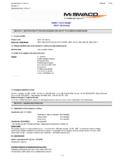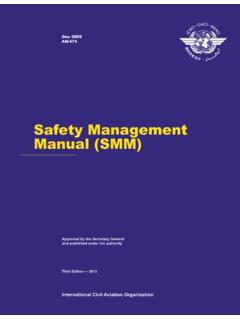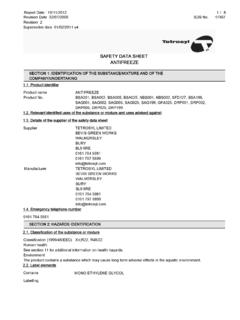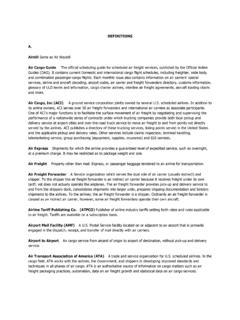Transcription of SAFETY DATA SHEET CITRIC ACID - IGas | Home
1 Revision Date 28-Feb-13 Revision 6 Supersedes date 14-Mar-08 SDS No. 11350 SAFETY data SHEET CITRIC ACIDSECTION 1: IDENTIFICATION OF THE SUBSTANCE/MIXTURE AND OF THE Product identifierProduct nameCITRIC Relevant identified uses of the substance or mixture and uses advised againstIdentified usesOil well drilling fluid additive. pH Details of the supplier of the SAFETY data sheetM-I SWACOS upplierA Schlumberger CompanyWoodlands DriveKirkhill Industrial EstateDyce, Aberdeen AB21 0 GWScotland UKT=+44(0)1224-246600F=+11(0)1224-246699 Email - Emergency telephone number(24 Hour) Australia +61 2801 44558, Asia Pacific +65 3158 1074, China +86 10 5100 3039, Europe +44 (0) 1235 239 670, Middle East and Africa +44 (0) 1235 239 671, New Zealand +64 9929 1483, USA 001 281 561 Emergency Telephone Number+31 (0)30-2748888 Only for the purpose of informing medical personnel in cases of acute intoxications in the 2: HAZARDS Classification of the substance or mixtureClassification (EC 1272/2008)Physical and Chemical HazardsNot healthEye Irrit.
2 2 - H319 EnvironmentNot (1999/45/EEC)Xi; Full Text for all R-Phrases and Hazard Statements are Displayed in Section Label elementsLabel In Accordance With (EC) No. 1272/2008 Signal WordWarningHazard StatementsH319 Causes serious eye StatementsP337+313If eye irritation persists: Get medical Precautionary StatementsP280 Wear protective gloves/protective clothing/eye protection/face contaminated skin thoroughly after No. 11350 CITRIC ACIDP305+351+338IF IN EYES: Rinse cautiously with water for several minutes. Remove contact lenses, if present and easy to do. Continue Other hazardsNot Classified as PBT/vPvB by current EU 3: COMPOSITION/INFORMATION ON MixturesCITRIC acid MONOHYDRATE60-100%CAS-No.: 5949-29-1EC No.:Classification (67/548/EEC)Xi; (EC 1272/2008)Eye Irrit.
3 2 - H319 The Full Text for all R-Phrases and Hazard Statements are Displayed in Section CommentsThe data shown is in accordance with the latest EC 4: FIRST AID Description of first aid measuresInhalationMove the exposed person to fresh air at once. If respiratory problems, artificial respiration/oxygen. Get medical attention if any discomfort give a couple of glasses of water or milk, provided the victim is fully conscious. Get medical attention if any discomfort contactRemove contaminated clothing immediately and wash skin with soap and water. Get medical attention promptly if symptoms occur after contactMake sure to remove any contact lenses from the eyes before rinsing. Promptly wash eyes with plenty of water while lifting the eye lids. Continue to rinse for at least 15 minutes and get medical Most important symptoms and effects, both acute and delayedGeneral informationThe severity of the symptoms described will vary dependant of the concentration and the length of exposure.
4 If adverse symptoms develop as described the casualty should be transferred to hospital as soon as possible. For further information, please refer to section Indication of any immediate medical attention and special treatment neededTreat 5: FIREFIGHTING Extinguishing mediaExtinguishing mediaWater spray, foam, dry powder or carbon Special hazards arising from the substance or mixtureHazardous combustion productsFire or high temperatures create: Irritating gases/vapours/fumes of: Carbon monoxide (CO). Carbon dioxide (CO2).Unusual Fire & Explosion HazardsHigh concentrations of dust may form explosive mixture with Advice for firefightersSpecial Fire Fighting ProceduresContainers close to fire should be removed immediately or cooled with equipment for fire-fightersSelf contained breathing apparatus and full protective clothing must be worn in case of No.
5 11350 CITRIC ACIDSECTION 6: ACCIDENTAL RELEASE Personal precautions, protective equipment and emergency proceduresWear protective clothing as described in Section 8 of this SAFETY data Environmental precautionsDo not allow to enter drains, sewers or Methods and material for containment and cleaning upAvoid generation and spreading of dust. Remove spillage with vacuum cleaner. If not possible, collect spillage with shovel, broom or the like. Flush with plenty of water to clean spillage area. Do not let washing down water contaminate ponds or Reference to other sectionsFor waste disposal, see section 7: HANDLING AND Precautions for safe handlingAvoid inhalation of dust and contact with skin and eyes. Avoid handling which leads to dust Conditions for safe storage, including any incompatibilitiesStore in tightly closed original container in a dry, cool and well-ventilated place.
6 Store separated from: Alkalis. Oxidising ClassChemical Specific end use(s)The identified uses for this product are detailed in Section 8: EXPOSURE CONTROLS/PERSONAL Control parametersIngredient CommentsNUI = Nuisance dust, WEL TWA 4mg/m3 Respirable Dust, 10 mg/m3 Total Exposure controlsProtective equipmentProcess conditionsAll chemical Personal Protective Equipment (PPE) should be selected based on an assessment of both the chemical hazard present and the risk of exposure to those hazards. The PPE recommendations below are based on an assessment of the chemical hazards associated with this product. Where this product is used in a mixture with other products or fluids, additional hazards may be created and as such further assessment of risk may be required.
7 The risk of exposure and need of respiratory protection will vary from workplace to workplace and should be assessed by the user in each measuresProvide adequate general and local exhaust equipmentNo specific recommendation made, but respiratory protection may still be required under exceptional circumstances when excessive air contamination exists. Wear mask supplied with: Dust filter P2 (for fine dust).Hand protectionFor prolonged or repeated skin contact use suitable protective gloves. Butyl rubber. Polyvinyl chloride (PVC).Eye protectionWear approved SAFETY ProtectionWear appropriate clothing to prevent any possibility of skin contact. Provide eyewash No. 11350 CITRIC ACIDSECTION 9: PHYSICAL AND CHEMICAL Information on basic physical and chemical propertiesAppearanceCrystals or in point ( C)153 CRelative @ 20 CBulk Density900 kg/m3pH-Value, Diluted @ 100g/lSolubility Value (G/100G H2O@20 C)60 Auto Ignition Temperature ( C)1010 Other informationNot relevantSECTION 10: STABILITY AND ReactivityViolent reaction with: Strong alkalis.
8 Strong oxidising Chemical stabilityStable under normal temperature conditions and recommended Possibility of hazardous reactionsNot Conditions to avoidNone Incompatible materialsMaterials To AvoidStrong alkalis. Strong oxidising Hazardous decomposition productsFire or high temperatures create: Irritating gases/vapours/fumes of: Carbon monoxide (CO). Carbon dioxide (CO2).SECTION 11: TOXICOLOGICAL Information on toxicological effectsToxic Dose 1 - LD 505040 mg/kg (oral-mouse)Toxic Dose 2 - LD 503000 mg/kg (oral rat)Acute toxicity:Acute Toxicity (Oral LD50)> 7000 mg/kg RabbitATE (Oral)3000 mg/kgAspiration hazard:Not anticipated to present an aspiration hazard based on chemical may irritate respiratory system or No. 11350 CITRIC ACIDI ngestionMay irritate and cause stomach pain, vomiting and contactSkin irritation is not anticipated when used contactCauses serious eye irritation.
9 Particles in the eyes may cause irritation and of entryNo route of entry OrgansNo specific target organs notedSECTION 12: ECOLOGICAL INFORMATIONE cotoxicityContact M-I SWACO's QHSE Department for ecological information at ToxicityAcute Fish ToxicityNot considered toxic to 50, 96 Hrs, Fish mg/l440 - Persistence and degradabilityDegradabilityThere are no data on the degradability of this Bioaccumulative potentialBioaccumulative potentialNo data available on Mobility in soilMobility:The product is soluble in Results of PBT and vPvB assessmentThis product does not contain any PBT or vPvB Other adverse effectsNone 13: DISPOSAL Waste treatment methodsRecover and reclaim or recycle, if practical. Dispose of waste and residues in accordance with local authority ClassEWC-code: 06 01 06.
10 7134. Organic 14: transport INFORMATIONG eneralThe product is not covered by international regulation on the transport of dangerous goods (IMDG, iata , ADR/RID). UN numberNot UN proper shipping nameNot No. 11350 CITRIC transport hazard class(es)Not Packing groupNot Environmental hazardsEnvironmentally Hazardous Substance/Marine Special precautions for userNot transport in bulk according to Annex II of MARPOL73/78 and the IBC CodeNot applicable. Please contact for info regarding transport in 15: REGULATORY SAFETY , health and environmental regulations/legislation specific for the substance or mixtureUk Regulatory ReferencesChemicals (Hazard Information & Packaging) Regulations. Control of Substances Hazardous to Health Regulations 2002 (as amended) Workplace Exposure Limits LegislationRegulation (EC) No 1907/2006 of the European Parliament and of the Council of 18 December 2006 concerning the Registration, Evaluation, Authorisation and Restriction of Chemicals (REACH), establishing a European Chemicals Agency, amending Directive 1999/45/EC and repealing Council Regulation (EEC) No 793/93 and Commission Regulation (EC)










